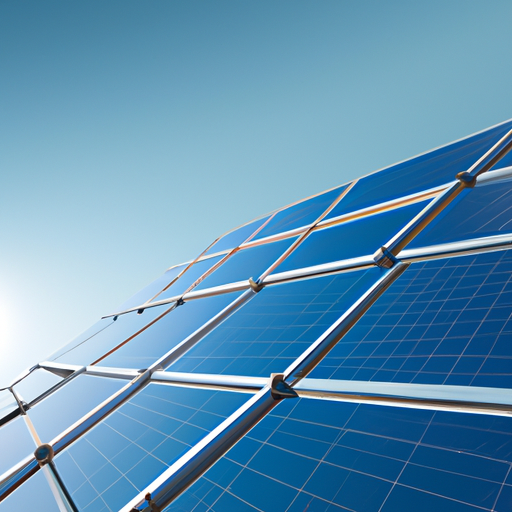

So, you’ve decided to go solar and install a grid-tied solar panel system, but now you’re wondering if you can also incorporate a solar energy storage system into the mix. The short answer is yes, you absolutely can! In fact, combining a solar energy storage system with a grid-tied solar panel installation can provide numerous benefits and increase the efficiency of your overall solar setup.
Now, let’s dive into a bit more detail. A grid-tied solar panel installation allows you to generate your own electricity from the sun and feed any excess energy back into the grid. This means that when your solar panels produce more electricity than you need, the surplus energy is sent to the grid and you receive credits for it. On the other hand, when your panels aren’t producing enough energy, you can draw electricity from the grid.
But what happens when there’s a power outage and you still want to have electricity in your home? This is where a solar energy storage system, commonly referred to as a solar battery, comes into play. By installing a solar battery alongside your grid-tied solar panel system, you can store any excess energy during the day and use it at night or during power outages. This provides you with greater energy independence and can even help you save money by reducing your reliance on the grid.
Curious to learn more about solar energy storage systems? Keep reading, and we’ll provide you with all the information you need to determine if it’s the right option for you and your grid-tied solar panel installation. If you’re considering installing a solar energy system for your home or business, you may have wondered if it’s possible to use a solar energy storage system in conjunction with a grid-tied solar panel installation. In this article, we will explore the components, benefits, considerations, and installation process of using a solar energy storage system alongside a grid-tied solar panel installation.


What is a Solar Energy Storage System?
A solar energy storage system, also known as a solar battery, is a device that can store electricity produced by solar panels. It allows you to store excess energy generated during the day and use it at night or during periods of low solar production. This can help you maximize the utilization of your solar energy system and reduce your reliance on the grid.
Definition and Components of a Solar Energy Storage System
A solar energy storage system is typically composed of a battery bank, an inverter, a charge controller, and monitoring equipment. The battery bank stores the energy generated by the solar panels, while the inverter converts the stored DC electricity into AC electricity for use in your home or business. The charge controller regulates the charging and discharging of the batteries, ensuring optimal performance and lifespan. Monitoring equipment allows you to track the performance and efficiency of your storage system.
How Does a Solar Energy Storage System Work?
During the day, when your solar panels are producing more electricity than you are consuming, the excess energy can be stored in the battery bank. This stored energy can then be used at night or during periods of low solar production. The inverter converts the stored DC electricity into AC electricity, which can be used to power your home or business. If the battery bank is fully charged or if there is a power outage, excess solar energy can be exported to the grid or used to charge electric vehicles.
What is a Grid-tied Solar Panel Installation?
A grid-tied solar panel installation, also known as an on-grid solar system, is a solar energy system that is connected to the grid. It allows you to generate clean energy from the sun and feed the excess energy back into the grid. This can result in savings on your electricity bill and even the possibility of earning credits for the excess energy you generate.
Definition and Components of a Grid-tied Solar Panel Installation
A grid-tied solar panel installation consists of solar panels, an inverter, and a grid connection. The solar panels convert sunlight into DC electricity, which is then converted into AC electricity by the inverter for use in your home or business. The excess energy produced by the solar panels is fed back into the grid.
How Does a Grid-tied Solar Panel Installation Work?
When sunlight hits the solar panels, they generate electricity. The inverter converts the DC electricity produced by the solar panels into AC electricity, which can be used to power your home or business. If you are consuming more electricity than your solar panels are producing, you can draw power from the grid. On the other hand, if your solar panels are producing more electricity than you are consuming, the excess energy is fed back into the grid.
The Compatibility of Solar Energy Storage System and Grid-tied Solar Panel Installation
Now that we understand the basics of a solar energy storage system and a grid-tied solar panel installation, let’s explore whether these two technologies can be used together.
Can a Solar Energy Storage System be Used with a Grid-tied Solar Panel Installation?
The answer is yes, you can definitely use a solar energy storage system in conjunction with a grid-tied solar panel installation. In fact, combining these two technologies can offer several benefits, including energy independence, maximized solar energy utilization, and backup power during outages.
Benefits of using a Solar Energy Storage System in Conjunction with a Grid-tied Solar Panel Installation
One of the primary benefits of using a solar energy storage system alongside a grid-tied solar panel installation is energy independence. With a storage system, you can store excess solar energy and use it when the sun is not shining. This reduces your reliance on the grid and gives you greater control over your energy consumption.
Another advantage is maximized solar energy utilization. Instead of exporting excess energy back into the grid, you can store it in the battery bank for later use. This means you can make the most of the electricity generated by your solar panels and reduce wastage.
Additionally, having a solar energy storage system can provide backup power during outages. If there is a power outage, you can use the stored energy in your battery bank to power essential appliances and keep your lights on. This can be particularly beneficial in areas prone to frequent power outages or during emergencies.


Advantages of Using a Solar Energy Storage System in Conjunction with a Grid-tied Solar Panel Installation
Using a solar energy storage system alongside a grid-tied solar panel installation offers several advantages, including energy independence, maximized solar energy utilization, and backup power during outages.
Energy Independence and Reduced Reliance on the Grid
By storing excess solar energy and using it when the sun is not shining, you can reduce your reliance on the grid and achieve greater energy independence. This can help you save on electricity costs and provide peace of mind during potential grid disruptions.
Maximized Solar Energy Utilization
Instead of exporting excess energy back into the grid, a solar energy storage system allows you to store and utilize that energy later. This means you can make the most of the electricity generated by your solar panels and minimize wastage. It also gives you more control over your energy consumption and allows you to optimize your energy usage patterns.
Backup Power during Outages
With a solar energy storage system, you can have access to backup power during power outages. If there is a disruption in the grid, you can use the stored energy in your battery bank to power essential appliances and keep your lights on. This is particularly advantageous in areas with unreliable grid infrastructure or during emergencies.
Considerations When Using a Solar Energy Storage System with a Grid-tied Solar Panel Installation
While combining a solar energy storage system with a grid-tied solar panel installation offers numerous benefits, there are certain considerations to keep in mind.
Appropriate Sizing of the Storage System
It is crucial to ensure that the storage system is appropriately sized to meet your energy requirements. An undersized storage system may not be able to store enough energy, while an oversized system may result in unnecessary costs. It is advisable to consult with a solar energy professional to determine the optimal size for your storage system.
Cost Considerations
Adding a solar energy storage system to a grid-tied solar panel installation can increase the overall cost of the system. It is essential to consider the upfront costs of the storage system, including the battery bank, inverter, and other components, as well as any additional installation and maintenance costs. However, it is important to note that the prices of solar energy storage systems have been decreasing over the years, making them more accessible and affordable.
System Integration and Compatibility
When adding a solar energy storage system to an existing grid-tied solar panel installation, it is important to ensure compatibility and proper integration between the two systems. The inverter used for the solar panels must be compatible with the storage system, and appropriate monitoring and control systems should be in place to optimize the performance and efficiency of the overall system.
Installation Process for Solar Energy Storage System in Conjunction with a Grid-tied Solar Panel Installation
The installation process for a solar energy storage system in conjunction with a grid-tied solar panel installation typically involves several steps.
Assessment and Design Phase
During this phase, a solar energy professional will assess your energy needs and requirements. They will evaluate your current electricity usage, the size of your existing solar panel system, and other factors to determine the optimal size and configuration of the storage system. A detailed design plan will be created, considering factors such as available space, compatibility with existing equipment, and safety regulations.
Permitting and Approvals
Before installing a solar energy storage system, it may be necessary to obtain permits and approvals from the relevant authorities. This ensures that the installation complies with local regulations, building codes, and safety standards. The solar energy professional will assist you in navigating this process and handling any necessary paperwork.
Installation and Commissioning
Once all the necessary permits and approvals have been obtained, the installation process can begin. The storage system components, including the battery bank, inverter, and charge controller, will be installed according to the design plan. The system will then be commissioned, which involves testing and configuring the components to ensure they are functioning optimally.
Maintenance and Monitoring of the Solar Energy Storage System
To ensure the continued performance and efficiency of your solar energy storage system, regular maintenance and monitoring are essential.
Regular Maintenance Requirements
The specific maintenance requirements of a solar energy storage system will depend on the type and brand of the equipment used. However, common maintenance tasks include cleaning the solar panels to remove dirt and debris, inspecting the battery bank for any signs of damage or deterioration, and checking the charge controller and inverter for proper functioning. It is recommended to follow the manufacturer’s guidelines and consult with a solar energy professional for maintenance advice.
Monitoring Performance and Efficiency
Monitoring the performance and efficiency of your solar energy storage system can help identify any issues or inefficiencies and allow for timely troubleshooting and optimization. Many storage systems come with monitoring capabilities that allow you to track energy production, energy usage, battery state of charge, and other important parameters. Regularly reviewing this data can help you assess the performance of your system and make adjustments if needed.
Potential Challenges and Risks
While using a solar energy storage system in conjunction with a grid-tied solar panel installation offers numerous benefits, there are certain challenges and risks to be aware of.
Battery Performance and Lifespan
The performance and lifespan of the batteries used in solar energy storage systems can vary depending on factors such as the type of battery, usage patterns, and maintenance. It is important to carefully select high-quality batteries and follow the manufacturer’s guidelines for proper maintenance and usage. Regular monitoring of the battery performance and timely replacement if necessary can help mitigate any potential issues.
Compatibility Issues
When combining a solar energy storage system with an existing grid-tied solar panel installation, compatibility between the various components is crucial. The inverter used for the solar panels must be compatible with the storage system, and proper integration and synchronization are necessary to ensure optimal performance. It is advisable to consult with a solar energy professional to ensure compatibility and make any necessary adjustments.
Safety Considerations
Solar energy storage systems involve the use of batteries, which can pose safety risks if not handled properly. It is important to follow safety guidelines for battery installation, usage, and maintenance to minimize the risk of fire, explosion, or other hazards. Additionally, proper grounding, circuit protection, and electrical safety measures should be in place to ensure the safe operation of the entire system.
Financial Incentives and Return on Investment
Using a solar energy storage system in conjunction with a grid-tied solar panel installation can offer financial incentives and a positive return on investment.
Government Incentives and Rebates
Many governments offer incentives and rebates to promote the adoption of renewable energy systems. These can include tax credits, grants, and other financial incentives. It is advisable to research the available incentives in your area and consult with a solar energy professional to take full advantage of these opportunities.
Energy Cost Savings and Payback Period
By combining a solar energy storage system with a grid-tied solar panel installation, you can reduce your reliance on the grid and potentially save on electricity costs. The excess energy generated by your solar panels can be stored and used when the sun is not shining, reducing the need to purchase electricity from the grid. The payback period for your investment will depend on various factors, including the cost of the system, the amount of energy you consume, and the local electricity rates. However, many solar energy storage system owners report achieving a positive return on investment within a reasonable timeframe.
Conclusion
In conclusion, combining a solar energy storage system with a grid-tied solar panel installation offers numerous benefits, including energy independence, maximized solar energy utilization, and backup power during outages. While there are considerations and potential challenges to be aware of, with proper planning, installation, and maintenance, this combination can provide a reliable and sustainable energy solution for your home or business. As the costs of solar energy storage systems continue to decrease and technology advancements continue, the potential and growth of these systems will likely increase in the future. By taking advantage of the financial incentives and rebates available, you can make the transition to clean, renewable energy and reduce your environmental impact while potentially saving money in the long run.



